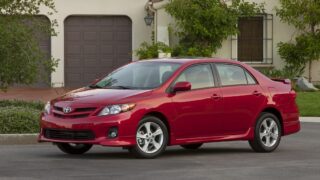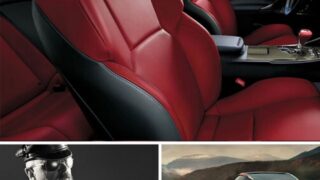The Lexus LFA: No Longer a Paper Tiger
The long anticipated Lexus LFA supercar in its production form has finally started to appear here in the US. It’s a symbol of Lexus great engineering and capabilities, and marks a lot of firsts in Lexus history. So what exactly does the 552hp Lexus LFA bring to the table? What is all the hype about? Let’s find out

In
the world of supercars and exotics, sky is the limit. Over the years, manufacturers in this market
have been working hard to squeeze out every single last bit of performance from
their vehicles. More power, better handling,
higher top speed, faster acceleration, better braking, etc… Furthermore, we see more and more players in
this game as well. Besides the tradition
brands like Ferrari and Lamborghini, we saw brands like Mercedes-Benz and Audi
trying to enter this segment in recent years. One thing clear is most of these companies are European brands. That seems to create a culture where
discussions of supercars and exotics hardly go outside of European products.
Historically,
Japanese auto manufacturers have been known for their remarkable quality and
reliability. They are capable of making
some fast cars too, Toyota Supra Twin-Turbo, Nissan 300z, and most recently the
Nissan GTR to name a few. They put up
some incredible numbers and have always been appreciated, however, they just
never carry or bring out the kind of design hue supercars or exotics would
bring to the table.
But
it’s not like Japanese manufacturers aren’t capable of doing so, we do see
examples throughout the years. To start,
look at the Toyota 2000GT in the 1960s, in some
way it shocked the world about what Toyota
was capable of. With the car Toyota set a lot of
records, and prompted some European brands to scramble into pushing out new
vehicles to compete.
Fast
forward 2 decades, the well-known Honda NSX is another prime example about
Japanese vehicle production defying the odds and earning respects from all enthusiasts
all over the world. In 1984, Honda set
out to create a car that will rival the best from Europe including Ferrari, while
offering great reliability and affordability. 5 years later, the NSX was born and it shocked the world. For a fraction of the cost, you could get a
car with styling close to that of any exotics, performance and engineering so
advanced it gave most supercars a good run for the money. The NSX earned the title “a poor man’s
Ferrari.” In some sense, it’s a great
compliment on how much Honda had achieved.
However,
the disconnect continues since then. European exotic brands continue to evolve and push out new models, but
Japanese brands started to get quiet again and we haven’t see anything as
exciting.
That
was until few years ago when Lexus announced their development of an all-new
super car, the Lexus LFA. They promised
something completely new from the ground up, a complete re-think of what an
ultimate performance machine should be about, in the eyes of true driving
enthusiasts.
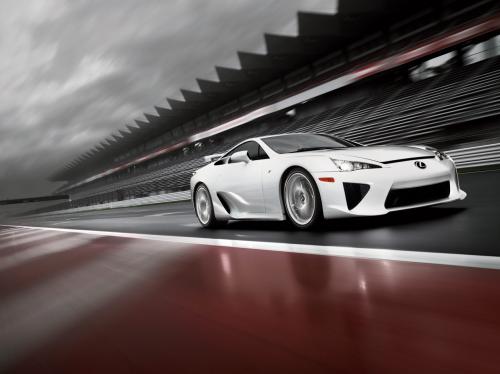
The long waited Lexus LFA
Step Zero – Take Away
the Unnecessary
If
one doesn’t realize how fast technology progresses these days, the LFA is a prime
example. Honda took 5 years to design
and produce the NSX (from 1984 to 1989), and for Lexus to find the right design
for production LFA, chief engineer Haruhiko Tanahashi and this team took a
whopping 10 years. That’s no small
investment on both time and money, but Toyota has the foundation and their commitments
on this project were clear.
In
the beginning stages of the LFA design, design team pointed out one of the
biggest enemy of performance – weight. So reducing the overall weight of the vehicle (without compromising
other aspects like safety and rigidity) was the foundation. Going with Aluminum was a natural starting
point for the vehicle considering its weight savings, but after few years of
study, Lexus quickly realized that they needed the car to go even lighter, and
technology suggests carbon fiber reinforced plastic (CFRP), which offers
further weight savings while maintaining very high strength in construction.
To
do it right, Toyota didn’t just outsource CFRP to someone, they wanted to study
and understand more about the construction. Moreover, Toyota
developed a new technology in joining process between the CFRP and metal alloy,
providing good joints and connections without creating unnecessarily weak
points. They also believe that looming
the carbon fiber into the exact shape of the components is vital to the overall
strength, compared to reshaping a piece of carbon fiber cloth. Given their experience in looming, Toyota decided
to just do everything in-house–including having their own 3D carbon fiber
looming machine. Talk about big
investment, this by itself is not cheap, another sign of pursuit of
perfection. So with the help of this
machine, components like the A-pillars of the LFA are loomed into shape
directly from the machine.
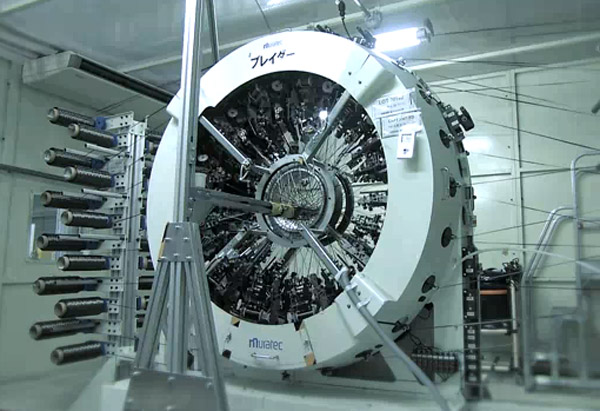
Lexus proprietary carbon fiber looming machine
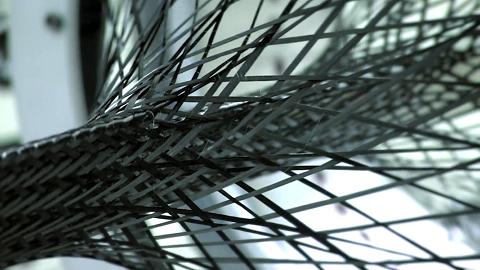
The Lexus LFA A-pillar being formed directly from the looming machine
With
this technology, 65% of the vehicle chassis are converted to CFRP, equaling
about 220lb of weight savings. In the
race to reduce the overall weight of the vehicle, this is one substantial
number.
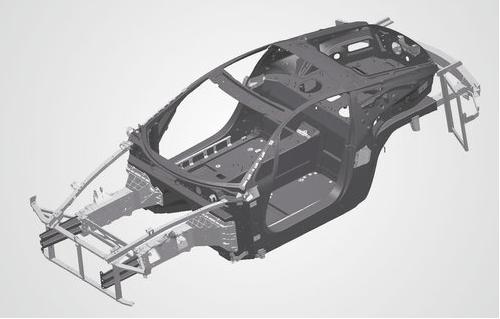
Diagram showing CFRP construction on the Lexus LFA chassis
The Heart – Smaller
Can Be Better
In
recent years, one very unhealthy thing about the high performance auto industry
is the unofficial “horsepower war.” Hardly any manufacturer admits it, but it’s very clear that most of them
got sucked into a pissing contest of “me having more horsepower than you.” On paper the horsepower number is a selling
point, however a lot of times it can hurt the vehicles (as well as industry)
just as much. Engines are getting bigger
and heavier, at the same time less efficient and negatively affecting the
balance of the car.
Lexus
saw this, and they didn’t take much interest in going after numbers for the
LFA. Instead, they looked at the whole
LFA package and decided what kind of engine setup would provide the best
performance and balance to the whole car, and at the same time meeting their
design philosophy.
What
they came up was quite unconventional but at the same time nothing less than
impressive. The engine is a relatively
small displacement 4.8L V10. Yes, that’s
a size of a typical V8 engine, but at the same time, because of its compact
construction and materials made out of forged aluminum or even titanium, the
overall weight of the engine is just that of a typical V6. Now that’s the best of both worlds!
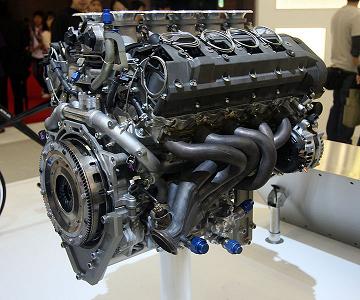
Lexus LFA V10 engine
Light
weight design compounded with precise manufacturing process allows this
incredible engine to rev up to a redline of 9000rpm. It produces peak power of 552hp at 8700rpm
and 354lb-ft of torque at 6800rpm. Together with ten carefully designed individual throttle bodies, the
engine can easily rev from idle to 9000rpm in just 0.6 second, so fast that a
traditional analog gauge can’t even keep up, prompting Lexus to create a full
digital display. This type of engine
design allows a very linear horsepower and torque delivery across the range, allowing
the driver to more easily control the vehicle around the track.
Further
more, besides the size and weight savings, Lexus also designed the engine in
such a way so that it’s placed lower than traditional engine. This allows a lower center of gravity, which
obviously benefit the handling of the car.
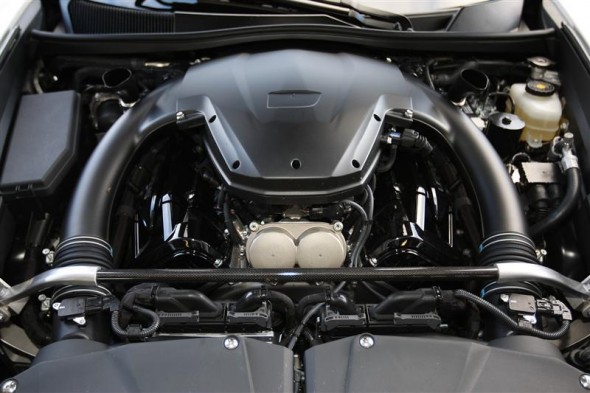
The 552hp V10 engine in the Lexus LFA
Gear Hunt – You Know
It’s Happening
Just
like most other front-engine, rear-wheel-drive performance car, in order to
achieve a balanced weight distribution, putting the transmission in the rear
makes sense. The six-speed Automated
Sequential Gearbox (ASG) that Lexus
ended up with is a compact light-weight single-clutch design, with the
transaxle sitting right above the rear axle. It’s connected with the front engine through a rigid torque tube.
Torque tube design and rear mounted transmission on the Lexus LFA
The
choice of going with single-clutch design was not easy. According to Tanahashi, they actually studied
the dual-clutch design, however what they found was that the gear shifting
actually got a little bit too smooth and make the car feel too much like a
traditional automatic. Instead, they
prefer the more pronounced sensation when a single-clutch transmission
shifts. Furthermore, a dual-clutch
design will likely be bigger and heavier as well, making it less attractive on
the LFA given the design philosophy.
But
the transmission on the LFA shouldn’t be taken lightly. Even though it’s a single-clutch design, the
shifting speed can be as fast as 200ms, in line with most other supercars out
there. The LFA has 4 pre-set driving
modes, Auto, Sport, Normal,
and Wet, allowing better versatility in different driving condition.
Even
though the LFA doesn’t carry a traditional stick shifter anymore in favor of
the paddle shifters mounted on the steering column, Lexus doesn’t forget about
driver feedback and senses. The right-hand
upshift paddle actually requires less effort so a slight click of your finger
and the transmission reacts immediately, whereas the left-hand downshift paddle
is tighter and requires more effort. This might seem not very noticeable, but it’s all these little things
that connect the driver and the vehicle tighter together than ever.
Grip – Never Let Go
With
that much power and torque, the ability to put all of them on the ground is the
key. The LFA is equipped with a special
double wishbone suspension up front and a multi-link suspension in the
rear. Again, Lexus looked into details
to reduce weight, including using hollow sway bars and forged aluminum
components.
For
wheels, just like the ISF, Lexus again went to BBS for specially designed 20″
forged aluminum light-weight wheels. The
wheels are wrapped with Bridgestone bespoke Potenza S001 265/35/20 and 305/30/20
tires. Bridgestone had been running this
proprietary version of the S001 on the LFA for a long time, even before its
initial debut, to make sure they can give the LFA the best performance on the
road.
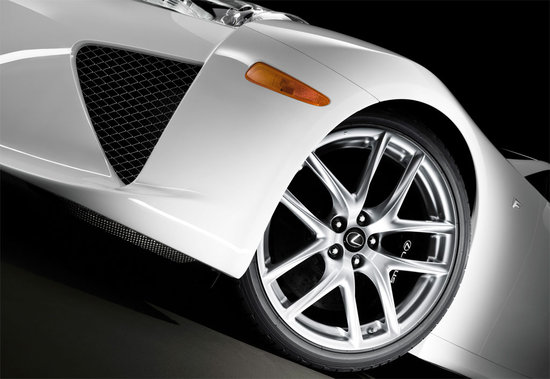
Wheel design on the Lexus LFA
When
you are able to go fast, the ability to stop fast is just as important. Lexus knew it well and they went to one of
the most well-known pioneers in brake technology – Brembo. They suited the LFA with 6-piston front and
4-piston rear monoblock calipers, paired with 2-piece Carbon Ceramic Material
(CCM) rotors, massive 390mm front and 360mm rear. The choice with carbon ceramic brakes is
crucial in high performance vehicles. The rotors are lighter (sprung weight), and they withstand heat far
better than traditional ones, diminishing the danger of brake fades in
continuous aggressive driving.
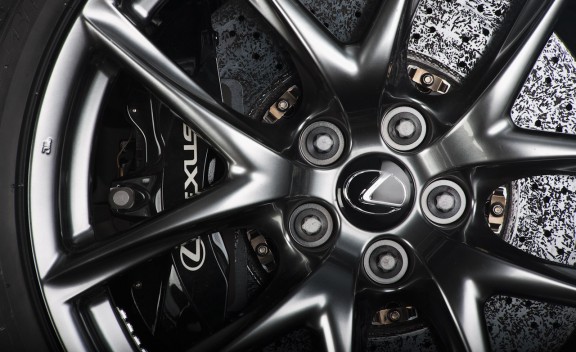
Carbon Ceramic Material (CCM) brake system behind light weight BBS forged aluminum wheel
Fine Tuning – Down to
the Note
With
10 years to design and develop the LFA, it only makes sense that every detail
of the vehicle has been thought out and justified.
When
it comes down to the sound, Lexus asked for help from musical division of
Yamaha. The goal is to replicate the
breath-taking Formula-1 engine sound as much as possible. The surge tank is designed with acoustic in
mind, defining the engine tone. Exhaust
exits the left and right banks of the engine through equal length exhaust
manifolds, joined together at the Titanium dual-stage exhaust silencer in the
back. All these carefully engineered
sound don’t just go everywhere, they are carefully fed back into the cabin
through three channels to produce a rich intake and exhaust sound to the driver
and passenger.
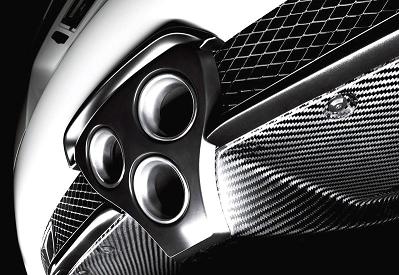
Lexus LFA exhaust opening in rear bumper
To
keep things closer towards the center of the car, nothing is overlooked,
including the windshield wipers fluid reservoir. You won’t find it in the front engine
compartment, because it’s hidden at the back of the driver seat location. When you pop the gas door, you will see the
reservoir inlet.
Down
to the last gram? Pop the hood. There is no hood struts, they are too
heavy. Instead you get an old-school
tradition hood rod, one that’s made out of CFRP.
Even
the two exhaust pipes going to the back of the car, they are “stacked” one on
top of another, and then the torque tube that connects the engine and the
transmission runs on top of that. All
this to make sure everything is as close to the center of the car as possible
for best weight distribution.
Exhaust manifolds stacked on top of each other
When
looking from the front, you will see a noticeable gap between the hood and the
bumper. It’s no design flaw or poor
fitment, it’s carefully design as an intake opening to suck in as much air as
possible. The two big opening on the
front bumper sides, they direct air flow to pass through the massive front CCM
brake system.
The
cooling system is also designed to extract heat from all over the car. Two large radiators are mounted in the rear
(you can see them through the rear bumper openings), and the system cycles all
the way to the front from side to side. Two big inlet openings right above the rear wheels behind the doors will
suck the air in, pass through the radiators and out from the rear of the car,
pulling away all the heat at the same time.
Two radiators are mounted at the back of the car
A
retractable rear wing will deploy itself at 50mph, producing more down force on
the back of the car at high speed. Similarly, the bottom of the vehicle is carefully designed and covered
for a full flat surface, producing a faster air flow and thus strong down force
from the top on the LFA.
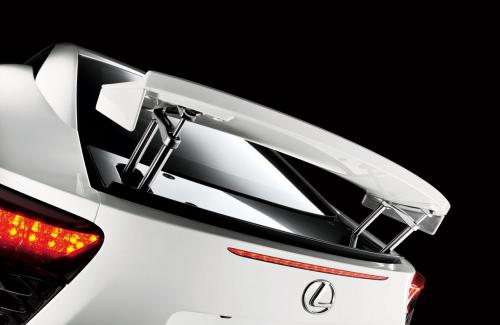
Retractable rear wing on the Lexus LFA
Overall,
the LFA carries a balanced 48/52 front/rear weight distribution. Lexus preferred this over the commonly used
50/50 distribution, believing that this will bring out the most driving
dynamics of the vehicle. All components
are placed as closed to the center as possible, and also within the wheel base
of the LFA. This is important as it will
minimize the moment of inertia and will aid overall handling.
Lexus LFA weight distribution and center of gravity
Lexus
is known for their reliability, but the Lexus LFA is different. It’s not a mass production car but its extreme
performance put a lot of stress on various components. So finding a way to test out the long term
reliability is important. What’s better
than putting almost the very same car in a real race? And what’s better than the Nurburgring
24-Hour Endurance Race to literally stress every part of the car? That’s what Lexus did, not once, not twice,
but 3 times from 2008 to 2010. The race
provided them with a lot of valuable information on problems that they couldn’t
foresee in regular test drives, promptly for more improvement in the final
production. And throughout the 3 races,
Lexus also gradually improved the results, and in the end placing first in its
class in the 2010 race!
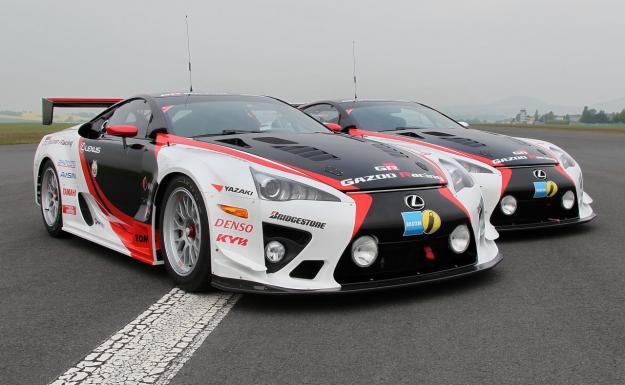
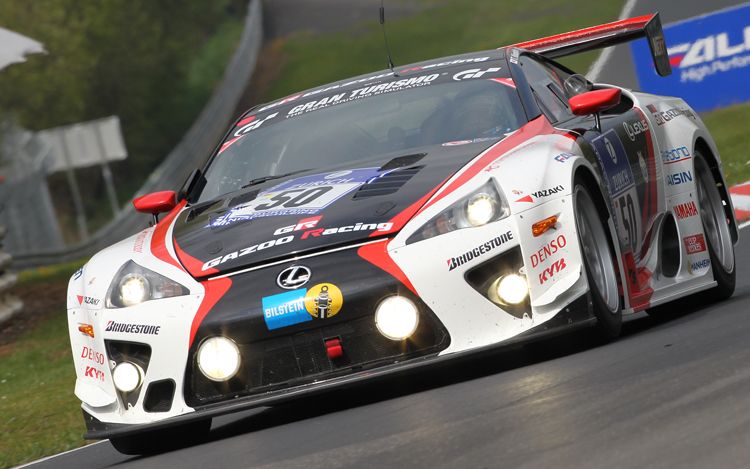
The Lexus LFA race cars that entered the Nurburgring
24-Hour Endurance Race
Cockpit – Center of Attention
Getting
into the cabin of the LFA and you know right the way it’s a Lexus. First off, you are sitting in the dead weight
center of the vehicle (front to rear), Lexus determines that this is the
optimal driving position. The detail of
attention is everywhere, including the feel and materials of all the components. Even down the bolts, you will see Lexus
stamps on them.
The
most important and noticeable piece is the tachometer, which is basically a
full Thin Film Transistor (TFT) LCD display with a motor-driven ring. The main reason behind this is not just
beauty but functionality as well. Since
the LFA engine is so responsive and it revs from idle to redline in less than a
second, tradition analog needle tachometer can’t even come close to accurately
represent the state of the engine, promptly for an all-new digital display.
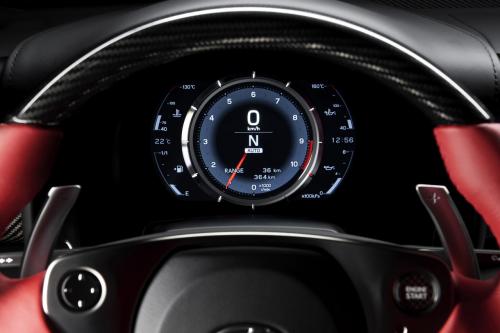
Lexus LFA interior dashboard design
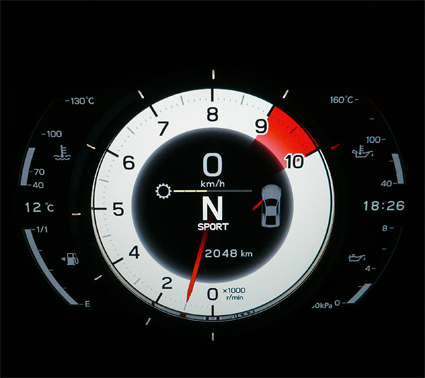
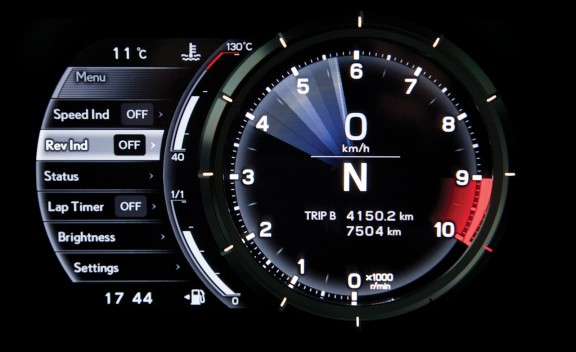
Thin Film Transistor (TFT) LCD display on the Lexus LFA. Left – Sports mode. Right – menus
Most
of the information and the settings can be accessed through this screen, giving
the driver full control very easily. And
just like every other Lexus, the LFA is equipped with a 7″ navigation system,
controlled through the new Lexus Remote Touch system. If you ever get tired of the engine tones (if
ever), the factory Mark Levinson audio system is always ready to intervene and
provides first-class audio playback.
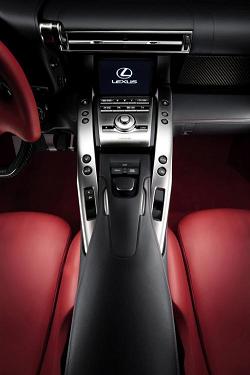

Lexus LFA interior center console
Often
times in other exotic vehicles, interior quality and details receive a lot of
criticism, but with their experience in other mainstream vehicles, Lexus
definitely has the advantage here.

Lexus LFA interior in red
Wallet – Yes It Hurts
Enough
with all the bells and whistles on this incredible master piece from
Lexus. So what’s the price tag on this
LFA? A not-so-friendly $375,000, which
easily drive away 90% of the public from even thinking about owning one. It’s not cheap by all means, though one will
argue that a lot of expensive options on other supercars like CCM brakes, audio
systems, etc… are already standard on the LFA, making the remaining options not
as crazy.
It
doesn’t stop there either, Lexus is only making 500 LFA and they claim to be
selecting their customers. So you will
have to be very much in the elite group, or maybe together with some luck, in
order to be able to own one.
It’s
pretty nontraditional the way Lexus is selling the LFA. They have no existing customer base on
vehicles at this price range, and it’s apparent that they are seeking out to a
whole new circle of owners. Whether this
idea works for them or not it’s still remained to be seen, but one thing for
sure. Unlike the Honda NSX, the LFA will
not be called a “poor man’s Ferrari” ever.
Numbers – What Does
It Translate Into?
So
let’s look at the LFA overall as a supercar, which it rightfully falls
into. Where does it stand? On paper, nothing really stands out like a
shining star right the way. It doesn’t
have V12 like the 599 or the LP640. Horsepower wise, 552hp also isn’t more than the 599 or LP640, both
pushing over 600hp. 0-60 on paper is
around 3.5 second, a Porsche 911 Turbo can match that already. Price wise at $375,000, it’s not particular
cheap at all like the Honda NSX where at the time everyone would called it a
great “bargain.” The car does carry the
Lexus badge, but to most people they name definitely isn’t as eye-catching as
Ferrari or Lamborghini.
However,
one will have to look deeper and further in order to really understand and
appreciate the Lexus LFA. It’s not a car
for everyone (with or without money). It’s for someone who is a true auto and driving enthusiasts, one who
appreciates the philosophy and engineering behind this Lexus master piece, and
of course, one with more than enough disposable income.
It
represents what Lexus, Tanahashi and his passionate design team have in mind
about a true driving machine. A car that
has size and weight in mind in every single component and placement, innovative
engineering like CFRP looming technology, compact engine design with high
efficiency, packaged with high degree of attention to details as well as world
class Lexus interior.
Not
only that, the car also represents what a true track performance car should
be. It’s not just about 0-60 or 1/4 mile
speed but the whole package of best time on the track. It’s not about how good a car brake once but
the ability to stop the car well laps after laps. It’s not only about what computer
calculations and adjustment can make the car but more important about the
connection between driver and the car in all senses.
All
these are what make this car worth every single penny to the buyers or
soon-to-be owners. It’s almost like the
willingness to pay big amount for a piece of art. Lexus first started testing their LFA
prototype on the famous Nurburgring race track in 2004, and it’s clear that to
them the overall performance as well as driving experience on the track holds a
very important position in their mindset.
Although,
at the same time, that might also be what make this car somewhat hard to
sell. Fact is, a lot of exotic and
supercar owners buy their cars for the brands and traditions, and in most
cases, about the status symbols as well. A lot of them don’t really care about how fast their cars are around the
track, they are about having fun with friends over the weekend cruising around
town. Nothing wrong with that, but to
these people, the Lexus LFA won’t appear to be as attractive.
If
one has to have some numbers to justify the Lexus LFA itself, reviews after
reviews the car has proven itself to be quite a performer. Top Gear, a well-known automotive show in the
UK,
reviewed the LFA and it actually holds the best wet track time of all at
1:22.8, putting it ahead of cars like 911 Turbo, GT3, F430 F1, all ran in dry. By speculations, the LFA in dry run should be
able to compete head to head or outperform Ford GT, 599 GTO, and LP640.
http://en.wikipedia.org/wiki/List_of_Top_Gear_test_track_Power_Lap_Times
On
the other hand, Car and Driver also reviewed the Lexus LFA together with the
Ferrari 599 HGTE, and the LFA actually won the comparison because the LFA
performance is more accessible and immediate, making the car more exciting to
drive.
http://blog.caranddriver.com/2011-ferrari-599-hgte-vs-2012-lexus-lfa-video/
Another
example is the AutoBild magazine, reviewing supercars like the Lexus LFA, Lamborghini
LP570-4, Mercedes SLS, and Porsche 911 Turbo S. The Lexus LFA lost in the overall score, but testing on Nurburgring
again shows that the LFA earned the fastest time among the cars.
But
you know what? Lexus probably doesn’t
really care that much into these number games (and thus never really publish
any specific track results). I read an
article by Chris Harris on Ferrari and magazine reviews (http://m.jalopnik.com/5760248/how-ferrari-spins)
and it reminded me of how too many are buying into the prints. Yes, that might be what sells a few more cars
to worshipers, but just like the horsepower war, it loses the true root of
supercars.
For
Lexus, they care about the LFA as a driving machine, one that connects with the
driver’s senses. They look at the high
speed stability from driver’s perspective. During the 2008 Nurburgring race, drivers also commented about how good
the car rode. That’s what Lexus cares
most in the end — the emotive performance.
Squeeze Harder
Now
if you have the cash for the Lexus LFA and you still think that’s not “enough”? Lexus has something more for
you–the Nurburgring Edition. It takes
the LFA to an even higher level, but of course, it is even more geared towards
track use.
The
Nurburgring Edition LFA features another extra 10hp, pushing the overall
horsepower to 562hp. For the
transmission, it’s calibrated to shift faster by 50ms, bringing the fastest
shift time to 150ms. There are some
other cosmetic changes on the car, including a fixed wing in the back as well
as different wheels.
Lexus
will only make 50 of this special edition, and the starting price is also
bumped up to $445,000. With that price
tag, you also get special track session as well as an annual pass to the famous
Nurburgring track.
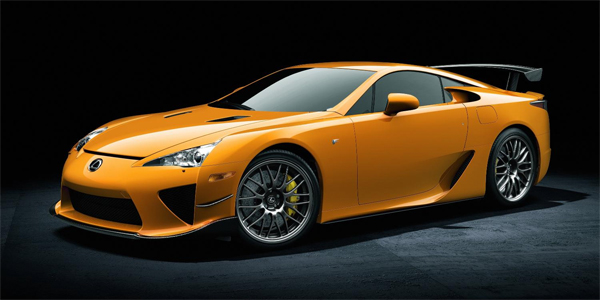
The ultimate Lexus LFA Nurburgring Edition
In Memory Of…
However,
the Lexus LFA does carry a bit of sad news with it. Hiromu Naruse, master test driver for Toyota and a well regarded
race car driver, unfortunately passed away when testing the LFA Nurburgring
Edition last year and crashed.

Hiromu Naruse, Toyota master test driver
Naruse
joined Toyota in 1963 and he has been part of
every sports car in Toyota’s
history. It was a tremendous loss on
Toyota and Lexus, given Naruse’s experience and his dedication in developing virtually
every sports car in Toyota history. His
spirits are sorely missed by every auto enthusiast, and I think everyone is
glad that Naruse was part of the LFA development. He ultimately made decision on every design
on the LFA, including numerous test drives, and his legacy will forever live
on.

Hiromu Naruse, driver force behind the Lexus LFA supercar
Lexus LFA – Define or
Defeat?
So
there it is, the Lexus LFA. It’s easily
the most exciting high performance vehicle from Japan since the Honda NSX. It carries aggressive exotic styling and
performance of most supercars out there.
In
some way, I think the LFA is here to re-define performance and driving. While most manufacturers are busy competing
on horsepower, 0-60, or some other numbers, Lexus quietly scraped everything,
went back to the drawing board and re-evaluated what true performance is as
well as what it takes to reach there.
True,
there will be people who argue that the Lexus LFA isn’t worth the money, given
the “numbers” that the car brings to the table, and more importantly that it
doesn’t carry a shinier badge to some. However, this is a case where you just have to throw away those
magazines or the spec sheets. The only
way to understand is to sit in one and drive. Feel for yourself how you are being connected to the car, how it reacts
to your every command, and how it feedbacks to you. A car can have a lot of power but goes out of
control every corner and the driver feels nothing but frustration. But a well balanced car will follow your
commands and give you the confidence as you power through the roads ahead.
Who
knows, maybe Tanahashi and his team created a car that they love to drive but
other people disagree. That’s remained
to be seen, although so far from various race car drivers as well as reviewers,
they are quite positive about the car. All I can say for sure is the Lexus LFA isn’t a car you compare on
paper, it’s a car you compare on the road.
That,
will take some serious driving enthusiasm to appreciate. That, is what Lexus is trying to define.
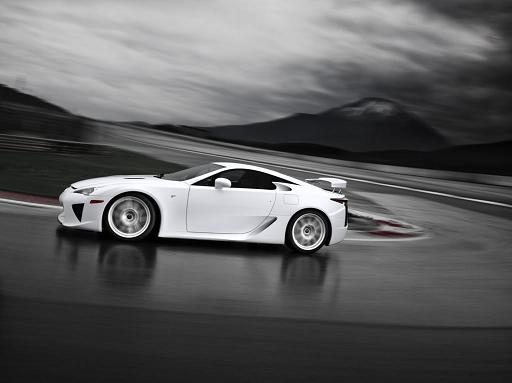
Where the Lexus LFA belongs
–by Henry K.
Courtesy: Lexus USA, Lexus.com, and Lexus-LFA.com
Please visit our forum thread here for discussions


